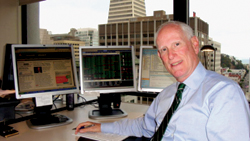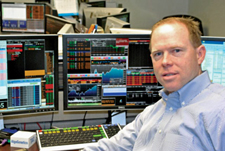The institutional buyside had little trouble finding liquidity over the last few days, as trading in the equity markets exploded amid a wave of volatility that hasn’t been seen since the financial crisis ebbed.
William Quinn, senior equity trader at HighMark Capital Management in San Francisco, said things were orderly despite broad media reports of market tumult. Furthermore, he added that he did not see panic selling from his clients. “We took advantage of the volatility to execute our customers’ sell orders,” Quinn said.

Despite the massive point swings, such as the Dow Jones Industrial Average plummeting 635 points on Monday, then rebounding 430 points yesterday, equity market liquidity has been excellent, buysiders report. So much so, that pros report multiple million-share prints over the last few days.
In fact, one large institution reported that its single-stock activity rose dramatically–and during a summer that had been the domain of the program trade. Indeed, trading has returned to the market, as volume more than doubled to more than 16 billion shares on Tuesday, up from an average of roughly 7.5 billion shares a day earlier this year.
The volatility finds its roots in a confluence of market circumstances that could hamper any buysider’s ability to trade. Traders are contending with a multitude of factors, such as the U.S. losing its Triple A credit rating, trouble in Europe’s banking system, lingering concerns over the state of several countries’ financial systems and a floundering global economy. Yet trading continues, as portfolio managers adjust their investment strategies.

Volatility has increased, begetting more trading opportunities. Volatility, as measured by the VIX, rose from 28.03 at the start of the trading session on Friday, Aug. 5, to a high of around 47.20 yesterday.
Accompanying the increase in volatility, trading volumes bounced back from their summer doldrums. Nearly 18 billion shares changed hands on Monday and 16.5 billion shares yesterday, according to BATS Trading. That’s compared to 8.5 billion shares traded on August 1.
Though markets have fallen dramatically, the situation differs dramatically from last year’s May 6 “flash crash” when a flood of sells and a near absence of buys forced the market precipitously downward.
Dennis Fox, head trader at Munder Capital Management, said it was business as usual at his firm. But portfolio managers have been eyeing opportunities for taking advantage of the market movement. “We’ve been feeding out some sell orders into the strength and getting taken.”
Another buyside trader seconded Munder’s strategy. He told Traders Magazine that despite the heavy volume, his firm’s portfolio managers were not active and were examining entrance points to the market in stocks that had dropped “more than their fair share” due to panic selling.

In spite of the selling pressures, there has been some follow-through buying. Craig Jensen, principal and head of trading at New Canaan, Conn.-based Armstrong Shaw Associates, said his firm has been “opportunistically adding” to its holdings and refusing to give in to some of the broad media hype surrounding the markets’ recent behavior.
“We were not participants in the selling,” Jensen said. “When things are as irrational as they were, we tend to take a step back. With that said we are long-term investors, so while we will not be the first ones in the market to buy, we look for opportunities to add to positions as things continue to move down.”
And there might be more buyers in the wings, waiting to get involved in the market. Clark McKinley, information officer at the California Public Employees Retirement System (CalPERS), said the $220 billion fund has “plenty of cash”–upwards of $5 billion as of May 31–at its disposal for buying opportunities in equities.

“We have the flexibility to make opportunistic shifts of capital to stocks if we wanted to buy low at this time; but that’s not saying we are doing that, only that we can,” McKinley said in an email response to questions from Traders Magazine.
The increased trading and liquidity has also given rise to more block and program trading. Dan Royal, co-head of global trading at Denver-based Janus Capital Group, told Traders Magazine that in recent days program trading continued unabated with little change in conviction on the part of portfolio managers.
“The only real conviction was the cash needs prompting the program trades,” Royal said. “Today [Tuesday] seems to be the first day recently where there’s more single stock liquidity.”
Royal said his inclination is to buy rather than sell, and many others are also using the current market as an opportunity to pick up stocks that they believe are undervalued.
As for block trading, Cheryl Cargie, senior trader at Ariel Capital Investments, said that while block orders had been absent from the market lately, they have returned somewhat.
“We were quiet during the early [Tuesday] morning,” said Cargie, adding that brokers began shopping more merchandise as the day wore on.
Alfred Eskandar, head of U.S. equities at block trading venue Liquidnet, told Traders Magazine the crossing network is enjoying healthy business. Its volume for the first week in August was the highest it’s been since November 2008. In the first week of this month, Liquidnet traded 434 million shares.

Its block trade size is also up slightly. Liquidnet’s average trade size in June was about 48,000 shares, according to Rosenblatt Securities. That rose to about 50,000 shares of late. “We’ve done million share prints today, and yesterday, and Friday,” Eskandar said. “Certainly the appetite for quantity discovery has not dissipated.”
He noted that institutions picked up their trading levels before the rest of the market and “well ahead” of the volume uptick of recent days. Eskandar interpreted this to mean it was more than just the U.S. debt downgrade that triggered the recent market activity.
“The European debt crisis has been in the news for quite some time” he said. Worries in Europe were a more likely culprit for heightened market activity than anything else, he added.
Even high frequency traders, who came under scrutiny regarding their commitment to liquidity following last year’s flash crash, are actively trading and making money. Last year, the group was accused of abandoning the market amid plummeting prices.
Manoj Narang, founder and chief executive officer of Tradeworx, a Red Bank, N.J.-based HFT, said his firm was profiting from the uptick in market activity.
“Volumes and volatility are both massively elevated–meaning that the demand for liquidity by long-term investors is high,” he said. “When the demand for a commodity is high, be it crude oil or liquidity, the profits for suppliers of the commodity tend to be high as well.”
–James Armstrong contributed to this story




